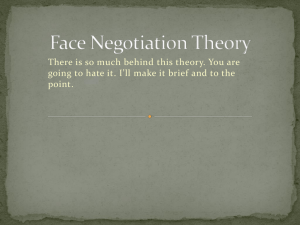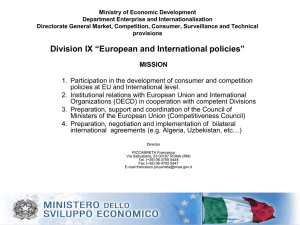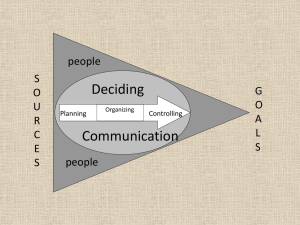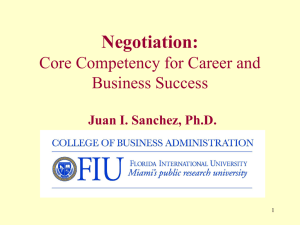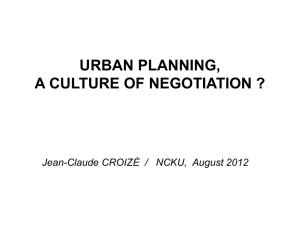Face - cowxp.net
advertisement
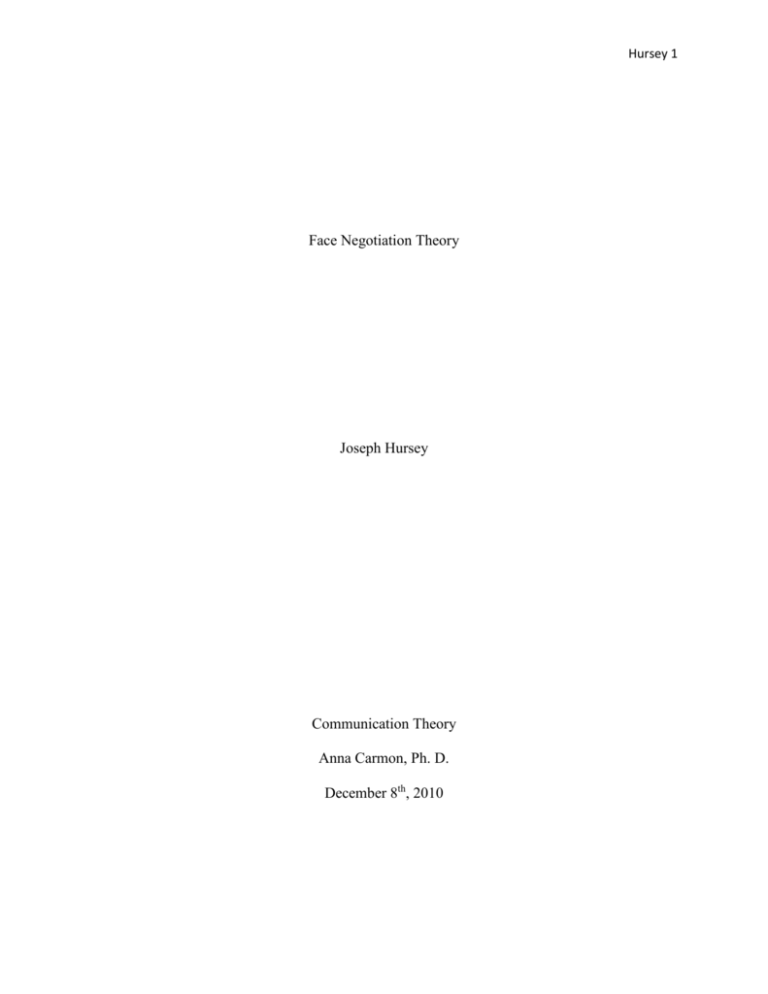
Hursey 1 Face Negotiation Theory Joseph Hursey Communication Theory Anna Carmon, Ph. D. December 8th, 2010 Hursey 2 Everyday people are making first impressions about other individuals based on the way they act, dress, speak, and present themselves. When meeting a person for the first time, an individual may attempt to present themselves in a professional and responsible manner. When leaving, they may wish to maintain this impression with the person they are meeting. When a professor interacts with a student in a classroom setting, they will most likely attempt to maintain their professional appearance to maintain the expectation of everyone around them. Face Negotiation Theory attempts to provide an explanation to reasons why individuals like the ones above communicate and behave the way they do in each situation. It is important to notice how individuals decide to manage their behavior between each situation. The use of Face Negotiation Theory in everyday interactions is a very passive process that many people do not even think about. To get a better understanding of why people act the way they do, particularly across different cultures, it is vital to explore the theory and its assumptions. Summary of Face Negotiation Theory When discussing “face” in the Face Negotiation Theory an individual should realize that face is “a metaphor for the public image that people display.” (West, Turner, 450). Face Negotiation Theory attempts to define exactly how cultures manage their communication and the conflict that arises during communication. It should be noted however, that even though the theory attempts to define how cultures manage these aspects, individuals within the same culture also attempt to maintain and strengthen face with each other as well. Conflict of any kind is an emotionally laden, face-threatening phenomenon (TingToomey, 72). How an individual would prepare to deal with this phenomenon depends on Hursey 3 several factors that Face Negotiation Theory outlines. First is the content conflict goal (TingToomey, 72), which defines issues that are out of the normal comfort zone of the individual involved. Next is the relational conflict goal (Ting-Toomey, 72). This conflict attempts to explain how each person views their relationship with the other individual. Last, identity-based goals (Ting-Toomey, 72), explains how people react in response to their feelings on how their face is currently being presented. Different forms of conflict must be recognized since it interacts with face and the individual’s perception of theirs, or another’s identity. Beyond the initial encounter, an individual’s perception of face will linger long after. Through conflict, “face can be threatened, enhanced, undermined, and bargained over (Ting-Toomey, 73).” If an individual feels like their face is being misinterpreted, they will engage in facework behavior. Facework refers to the specific verbal and nonverbal behaviors that we engage in to maintain or restore face loss and to uphold and honor face gain (Ting-Toomey, 73). The idea of maintaining, creating, and restoring face all help create the foundation of the theory, and develop the assumptions of Face Negotiation Theory. According to Toomey, "How we frame or interpret the situated meaning of face and how we enact facework differ from one cultural community to the next (Ting-Toomey, 73)." It is because of this, Face Negotiation Theory has 7 assumptions which are then further divided into additional propositions. The assumptions of Face Negotiation Theory can be used as a rough outline for the ideas of the theory. The first assumption explains, “People in all cultures try to maintain and negotiate face in all communication situations (Ting-Toomey, 73).” To summarize, this means individuals attempt to recognize another person’s opinion on them and make corrections that they believe would Hursey 4 make their face more neutral or appropriate for the situation. It does not matter the situation, an individual will pay attention to their self-image and adapt it towards the person they are with. A parent will act differently around their children, than they would with the teacher for example. The second assumption of Face Negotiation Theory is “the concept of face is especially problematic in emotionally vulnerable situations (such as embarrassment, request, or conflict situations) when the situated identities of the communicators are called into question (TingToomey, 73).” When individuals are in a stressful situation, they are more likely to feel more stressed about their face and appearance. The person in the awkward position may even feel their face is being misread in a negative manner when the opposite party has no intention of reading it that way. The third assumption states, “The cultural variability dimensions of individualismcollectivism and small/large power distance shape the orientations, movements, contents, and styles of facework (Ting-Toomey, 73).” Each culture has a respective style in terms of individualism and collectivism. An individualistic culture is one that places emphasis on the individual over the group (West, Turner, 457). A collectivistic culture places emphasis on the group over the individual (West, Turner, 457). Similar to the previous assumption, the next one expands on the idea that “individualismcollectivism shapes members' preferences for self-orientated facework versus other-orientated facework (Ting-Toomey, 73).” Very simply put, a person belonging to an individualistic culture would place more value on their own face. A person from a collectivistic culture would strive to create a positive face for the group, instead of just themselves. In a collectivistic culture it is sometimes more appropriate to worry about the face of another individual over their own. Hursey 5 In the fifth assumption goes on to explain some of the power distance between individuals. It goes into detail saying “small/large power distance shapes members' preferences for horizontal-based facework versus vertical-based facework (Ting-Toomey, 73).” A horizontalbased facework wishes to minimize the perception of power between individuals. The verticalbased facework likes to make it so the individual with the power gains a lot of authority. People of different power distances prefer different techniques which shape the interactions between individuals and groups. The sixth assumption defines “the cultural variability dimensions, in conjunction with individual (e.g., self-construal), relational (e.g., intimacy, status, ingroup/outgroup), and situational (e.g., topical salience) factors influence the use of particular facework behaviors in particular culture scenes (Ting-Toomey, 73).” Depending on the situation, people are more likely to employ certain facework behaviors that do a better job of preserving or restoring face. Individuals will strive to find these behaviors and use them effectively. The last assumption of Face Negotiation Theory explains that “intercultural facework competence refers to the optimal integration of knowledge, mindfulness, and communication skills in managing vulnerable identity-based conflict situations appropriately, effectively, and adaptively (Ting-Toomey, 73).” The more competent someone in recognizing facework, the more effective they will be at managing each situation. By being experienced in facework, it is expected that an individual will have the skills to appropriately deal with individuals on an intercultural level. Face Negotiation also brings in additional terms and concepts on top of the ones discussed that are important to understanding the theory. The first of which would be a positive Hursey 6 face. A positive face is the desire to be liked and desired by others (West, Turner, 450). The second term, negative face is a desire to be autonomous and free from others (West, Turner, 450). Other important terms include face saving, face restoration, and face management. Face-saving, efforts to avoid embarrassment or vulnerability (West, Turner, 455), is important in maintaining a positive view of one’s own face. This ties in efficiently with the term positive face, since both are looking to maintain liking from others. Face-restoration, a strategy used to preserve autonomy and avoid loss of face (West, Turner, 455), is useful for keeping the individual independent of others. This ties in well with negative face, since it also attempts to preserve autonomy. Face management, the protection of one’s face (West, Turner, 455), is similar to face saving. It protects your face before it has a negative association, even if you need to do it in a creative way such as striking a deal. Summary of research articles In the summary of the research articles, three different researches over how the Face Negotiation Theory works are presented and reviewed. Each article provides research on the topic of face and individuals experiences with facework. The first article paired together 768 participants. Each participant was then “questioned about a conflict they had experienced with the same gender, ethnic, and cultural group (Oetzel, Ting-Toomey, 607)” To make the study simpler, the variables being measured were “cultural I-C, selfconstrual, and face concerns (Oetzel, Ting-Toomey, 607).” Participants were categorized into individualistic cultures, or collectivistic, depending on their location. Each group of participants was then asked a series of questions that were relevant to the variables being studied. The reason for this initiative was to see if the behavior of the individuals matched with their culture. Hursey 7 The self-construal research took place with questions that were worded to be relevant to a situation that had conflict for the participant. The research itself found that the idea of “independence is more predominant in individualistic cultures (Oetzel, Ting-Toomey, 607)” and “interdependence is less predominant in an individualistic culture than it is in a collectivistic culture. (Ting-Toomey, 607)” This research helped prove self-construal research was accurate with the assumptions of Face Negotiation Theory. Face concerns was also a measured variable in the research. The dependent variables were avoiding, integrating, and dominating conflict styles (Oetzel, Ting-Toomey, 607). Face concerns were measured on a scale that sorted answers 1 through 5 in an effort to judge participants overall personality. The results from this particular research also maintained consistency with the assumptions of Face Negotiation Theory, further building credibility to the theory. The second article used 296 participants who were employed part time or full time in the past month. The sample consisted of 163 Anglo-Australians, and 133 East Asian ethnic Chinese students (Brew, Cairnes). This research was similar to the first research conducted by TingToomey and Oetzel; however this research also made an effort to introduce power distance into the equation as well as conflict management styles. Individuals within this study group had to complete a question with scale that they had to rank 1 through 8. Each individual was asked to answer honestly based on how they would react in each given situation. Each of them was also invited to an interview where they had to answer additional questions. The study attempted to find people from individualistic cultures as one test group, and East Asians from collectivistic for the other test group. The East Asian test group was not Hursey 8 allowed to have been residing in the United States for more than 5 years, to account for any kind of influence from culture. The Chinese test group must also be able to speak English as a second language to complete the questionnaire. “Hypothesis 1 predicted that Anglos would favor control and solution-oriented conflict management styles more than Chinese, who would favor a non-confrontational style more than Anglos. The means and standard deviations in Table 1 show that there are small differences along the predicted directions. (Brew, Cairnes)” The hypothesis created by Ting-Toomey to support the face negotiation theory was correct in judging the Anglos and their desire to be more conflict orientated. To the opposite thought, “Chinese were higher on non-confrontational and lower on solution-oriented and control than Anglos, supporting H1 (Brew, Cairnes).” TingToomey’s second hypothesis was also correct in stating that individuals from a collectivistic culture would be more likely to skip confrontation, further confirming the assumptions of Face Negotiation Theory. The final research article used a total of 184 individuals in order to test Ting-Toomey’s Face Negotiation Theory. It literally states, “The purpose of the current study is to use facenegotiation theory to explain interpersonal conflicts in organizations. (Lara, Meares, Myers, Oetzel, 109)” This research attempts to match Face Negotiation Theory’s predictions on the conflict styles of third party members. The hypothesis was as follows, “Self-face concern is associated positively with dominating, passive aggression, and emotional expression conflict styles, while other-face concern and mutual-face concern are associated positively with avoiding, obliging, compromising, integrating, and third-party help conflict styles (Lara, Meares, Myers, Oetzel, Hursey 9 109).” Individuals in an individualistic society (such as Anglos) would favor the self-face concern style. Individuals in the collectivistic culture (such as the East Asians) would favor the other-face concern style. “This hypothesis was supported for six of the eight conflict styles: integrating, compromising, dominating, emotional expression, obliging, and passive aggression. Face concerns were significant predictive factors for each of these conflict styles and, in fact, were collectively better predictors than the other variables for all of these styles (Lara, Meares, Myers, Oetzel, 108)” This research further expands on the idea that Face Negotiation Theory is accurately defining each culture’s role in conflict management. Theory Evaluation Although an accepted theory, Face Negotiation is not perfect by any means. There are certain criteria that each theory should be compared against in order to determine its effectiveness. This theory does accomplish fulfilling most of the criteria effectively. A good theory should be evaluated based on Scope, Logical Consistency, Parsimony, Utility, Testability, and Heurism. The scope of a theory refers to the breadth of communication behaviors covered (West, Turner, 69). The theories should be broad enough to be meaningful when discussing communication; however, the theory should also have a limit on how much it attempts to explain or it may get overcomplicated. Although controversial, the Face Negotiation Theory has a very clean and defined scope. Ting-Toomey attempts to combine the aspects of face, conflict, and culture to explain human communication. The issue, however, is that some cultures display face very differently than Hursey 10 others. In order to analyze the problem, additional facework definitions had to be included to combat the issue, and the individualistic and collectivistic views of the country in question had to be fully considered. This expands the scope of the theory greatly because they are including new factors to attempt to make the theory more effective. The scope of Face Negotiation Theory is still clearly laid out for the individual to analyze. It does not include too much that it attempts to become a grand theory. Face Negotiation attempts to define how humans interact and maintain face. Even with the additional individualistic and collectivistic views being considered, the scope is still focused on just face and facework. Logical Consistency states how a theory should make sense with itself, and maintain noncontradictory points (West, Turner, 69). Concepts of the theory should work together and provide predictable results from interactions. Assumptions of the theory should also be consistent with the claims. The theory should always operate within the limits of its assumptions, and should never push two ideas that conflict. The consistency of the Face Negotiation Theory has been recently corrected with the addition of the influence of individualism and collectivism. Previous to these additions, sometimes the theory would not match up with the expected results, and its accuracy would be questioned. To correct this, the scope of the theory was broadened to allow for the theory to become more consistent within itself. The theory maintains consistency through all aspects and therefore effectively displays logical consistency. Parsimony is how simple a theory is and how easily a theory can be understood (West, Turner, 69). A theory that is simple should only contain a few concepts and assumptions. In Hursey 11 order to properly use parsimony, simplicity should only be obtained while not making the theory seem incomplete. Face Negotiation Theory fails to maintain simplicity. There are too many terms and concepts throughout the theory that make the theory confusing to people that are not familiar with it. There are at least a dozen terms that start with the word face, and each of them all have a slight difference in them. The theory also had to add more terms as mentioned above to deal with inconsistencies within the theory, only making it more complicated. This theory does a very good job at defining what it should, but in order to do this, it sacrifices simplicity. Utility helps explain how useful a theory is, or how practical it actually is to real world experiences (West, Turner, 70). A theory with a large amount of utility will explain communication and human interaction effectively. If a theory has utility, it can be referred to in communication experiences, and be used to define how a situation is played out. A theory displaying utility can also help make a previously unclear communication more easily understood. Face Negotiation has a lot of usefulness, and can be used in every interpersonal situation. Because this theory also deals with cultural differences, no interaction is excluded. Any sort of conflict that arises can be analyzed effectively by applying this theory. The cultural significance of the theory also helps us analyze how individuals from other cultures may react to us, and also helps us maintain a proper face and communicate effectively with another individual. Testability refers to our ability to investigate a theory’s accuracy; it also deals with how testable concepts are within the theory (West, Turner, 70). A theory with a large amount of testability can be verified to work in each situation the way it is suppose to. Since Face Hursey 12 Negotiation is a cultural theory, it should be able to accurately explain what will happen upon each interaction. Since the theory is not parsimonious, it has a lot of concepts and terms to explain each interpersonal reaction. Through these additional terms, the theory attempts to cover every interaction effectively and accurately. For the most part, the theory does manage to do this. Through organizing cultures and assigning each person several aspects of face, Face Negotiation can accurately explain how people interact within each interpersonal relationship. The sacrifice of parsimony is what makes this theory so accurate, and it can be evaluated and verified by researchers in every interpersonal communication interaction. Heurism discusses how much interest and research is being created by the theory. If a theory has a high amount of Heurism, it produces a lot of additional insight and people feel more interested in researching it. Heurism does not require a lot of research activity, but it does require the theory to persuade some to put further research and time into it. Face Negotiation Theory is a relatively new theory, but it does display a large amount of Heurism. Since this is such a useful theory and has so many terms, a lot of researchers are interested in expanding on it and verifying its accuracy. Now that the world is becoming more culturally intertwined, this theory will have a lasting effect in explaining how we as individuals interact. This theory will continue to intrigue people as culture invades their lives. For the large majority of the criteria, Face Negotiation is effective in presenting itself as an appropriate and accepted theory. It demonstrates itself as being appropriate in almost every criteria except parsimony, but that was a sacrifice that had to be made to be effective in another field of criteria. Overall, the theory does a great job of accomplishing what it was set out to do, Hursey 13 and it can be seen with its confirmations throughout the each criterion required for an effective theory. Future Directions for Research Currently the Face Negotiation Theory is one of the main theories used for observing intercultural communication. Research is constantly being done on this theory in an effort to verify its accuracy and understand how humans interact. The theory is not researched to its fullest potential at the current moment though. Future research on this theory will expand as the world becomes a global marketplace. It is impossible to escape the presence of other cultures. One of the main things about this theory that needs to be re-evaluated and further researched on the affect of face on groups. Currently there is very little research done verifying exactly how face affects groups. The reason why is because the theory is very difficult to analyze with a large number of individuals, especially when applying the opinions of individualistic cultures. Lately there has been a lot of research surrounding the Face Negotiation Research, and even Ting-Toomey herself has been releasing scholarly articles on it recently in an effort to keep it recent and updated. Scholarly articles on Face Negotiation are being released every day, and the assumptions of Face Negotiation Theory can even be seen in other theories as well. Face Negotiation Theory can help everyone learn a little bit more about how people think and interact, no matter what culture they are from. By understanding exactly what kind of cultural background an individual has, an individual can make a reference to the Face Negotiation Theory and find out pretty accurately how an individual perceives face and how it should be treated. Hursey 14 Research in Face Negotiation should be expanded to include several groups of different views. For example, the theory sorely lacks in its ability to distinguish between mixed groups of people. Tests and research should be conducted until the theory manages to explain how all cultures, even mixed cultures, act towards each other. The fact that this theory cannot explain how face will be perceived or used in this situation makes it a little bit less suitable for explaining all cultural interactions. Additional research suggestions should also include a look at cultures that are not exactly individualistic, but also not exactly collectivistic. Not every culture falls perfectly on the scale. This is another weakness of Face Negotiation Theory since it attempts to categorize every type of culture into these two different groups. By introducing a third group in the middle of the present groups, it may be easier to apply the first research suggestion as well. The last research suggestion would be to attempt to simplify test groups into less specific terms. For example, the Face Negotiation Theory contains dozens of terms to explain nearly identical things. Research should be done on groups of individuals to gather terms that manage to define the groups as a whole, instead of defining single individuals and actions. This would help ease up the theory and get more individuals interested in researching it and adding onto it. Conclusion To conclude, it is important to realize that the idea of face is important for defining a person’s public image. Within this paper has been a discussion over the summary of the theory as a whole, an evaluation of its ability to meet expected standards, some research that verifies the accuracy of this theory, and a few additional ways this theory can be researched further. Face Negotiation is one of the most used intercultural communication theories to date, but still has a Hursey 15 lot of research and revisions being applied to it to make it more accurate and useful. Face Negotiation Theory will see a lot of additional research being done on it as the world becomes more connected through technology and cultures everywhere are expected to interact. Hursey 16 Works Cited Brew, Frances, and David R. Cairns. "STYLES OF MANAGING INTERPERSONAL WORKPLACE CONFLICT IN RELATION TO STATUS AND FACE CONCERN: A STUDY WITH ANGLOS AND CHINESE." International Journal of Conflict Management 15.1 (2004): 27-56. Print. Gudykunst, William B. "The Matrix of Face: An Updated Face-Negotiation Theory." Ed. Stella Ting-Toomey. Theorizing about Intercultural Communication. Thousand Oaks, CA: Sage, 2005. Print. Oetzel, John G., and Stella Ting-Toomey. "Face Concerns in Interpersonal Conflict: A CrossCultural Empirical Test of the Face Negotiation Theory." Communication Research 30.6 (2003): 599-624. Print. Oetzel, John G., Mary Meares, Keren Myers, and Lara Estefana. "Interpersonal Conflict in Organization: Explaining Conflict Styles via Face-Negotiation Theory." Communication Research Reports 20.2 (2003): 106-15. Print. West, Richard L., and Lynn H. Turner. Introducing Communication Theory: Analysis and Application. Boston: McGraw-Hill, 2010. Print.
